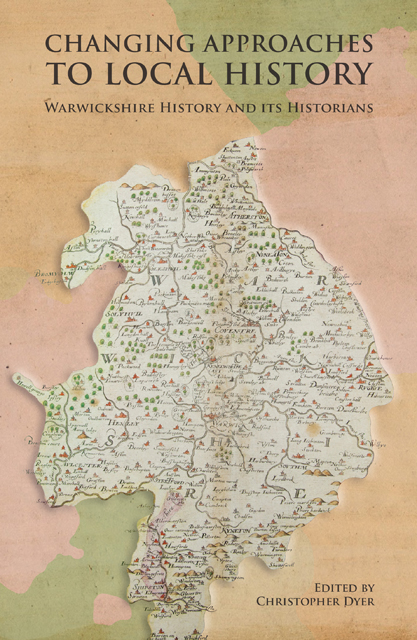Book contents
- Frontmatter
- Contents
- List of Illustrations
- Notes on Contributors
- Foreword
- Acknowledgements
- List of Abbreviations
- Introduction
- 1 The Dugdale Society: Its First Hundred Years
- 2 The Beginnings of Coventry
- 3 Was Commerce in Late Medieval Coventry Restricted by Regulation?
- 4 Studying Late Medieval Small Towns in Warwickshire 1920–2020
- 5 Rural Warwickshire in the Middle Ages: Society and Landscape
- 6 Religion, Rebellion and Red Jackets: Changing Approaches to Society and Politics in Sixteenth-century Warwickshire
- 7 Social Networks, Intellectual Affinities and Communal Harmony in Post-Reformation Warwickshire
- 8 Discovering Warwickshire’s Vernacular Architecture
- 9 Local History and the English Civil War: A View from Warwickshire
- 10 Writing Histories of the Landed Elite in Georgian Warwickshire
- 11 The Victoria County History in Warwickshire
- 12 Writing Women into the Political History of Warwickshire
- 13 Shakespeare and the Warwickshire Landscape in the Age of the Tourist
- Conclusion
- Index
Conclusion
Published online by Cambridge University Press: 17 December 2022
- Frontmatter
- Contents
- List of Illustrations
- Notes on Contributors
- Foreword
- Acknowledgements
- List of Abbreviations
- Introduction
- 1 The Dugdale Society: Its First Hundred Years
- 2 The Beginnings of Coventry
- 3 Was Commerce in Late Medieval Coventry Restricted by Regulation?
- 4 Studying Late Medieval Small Towns in Warwickshire 1920–2020
- 5 Rural Warwickshire in the Middle Ages: Society and Landscape
- 6 Religion, Rebellion and Red Jackets: Changing Approaches to Society and Politics in Sixteenth-century Warwickshire
- 7 Social Networks, Intellectual Affinities and Communal Harmony in Post-Reformation Warwickshire
- 8 Discovering Warwickshire’s Vernacular Architecture
- 9 Local History and the English Civil War: A View from Warwickshire
- 10 Writing Histories of the Landed Elite in Georgian Warwickshire
- 11 The Victoria County History in Warwickshire
- 12 Writing Women into the Political History of Warwickshire
- 13 Shakespeare and the Warwickshire Landscape in the Age of the Tourist
- Conclusion
- Index
Summary
This conclusion provides an opportunity to fill in some gaps, and to examine approaches used by the authors of the chapters, using the various specialist branches of history that have developed since 1920 as a framework. This book is intended to develop understanding of Warwickshire’s past for both outsiders and those already engaged with the subject, but also to explore general questions which apply in many other regions, including those outside the United Kingdom.
Birmingham
The first objective is to draw attention to the importance of Birmingham. A celebration of the Dugdale Society should acknowledge the vital role that historians based in Birmingham have played in its past, especially in its early days. As Bearman shows in chapter 1, the Society was formed from an alliance between Wellstood in Stratford and a group of Birmingham historians such as Humphreys, Carter, Houghton and Andrews. They belong to the ‘expert amateur’ category identified in the Introduction as important contributors to local history throughout the Society’s century. In the 1930s, history staff at the University of Birmingham developed links with the Society, and that association became even stronger in the post-war period.
Technical reasons can be found for the separation of Birmingham from Warwickshire, not just in the historical field. As described in the Introduction of this book, the modern city has extended its built-up area and its government across the county boundaries into Worcestershire and Staffordshire. The city belongs only in part to Warwickshire, and became much more than a Warwickshire town as Britain’s second city, ‘a city of a thousand trades’, ‘the workshop of the world’, a centre of science and technological innovation, especially in the eighteenth century, and in recent times a striking example of multiculturalism.
Birmingham’s historians have developed interpretations appropriate for an urban centre that stands on its own, which have been called ‘Birmingham exceptionalism’. The city has been portrayed as unique, not conforming to the general trends experienced in other towns, and developing a special path in unusual circumstances. The first claim was that in its formative years, from the fifteenth century until the nineteenth, it derived strength and dynamism from the lack of restraining government. The idea dates back to Hutton in the eighteenth century, and was given new historical authority in the mid-twentieth century by Gill.
Information
- Type
- Chapter
- Information
- Publisher: Boydell & BrewerPrint publication year: 2022
